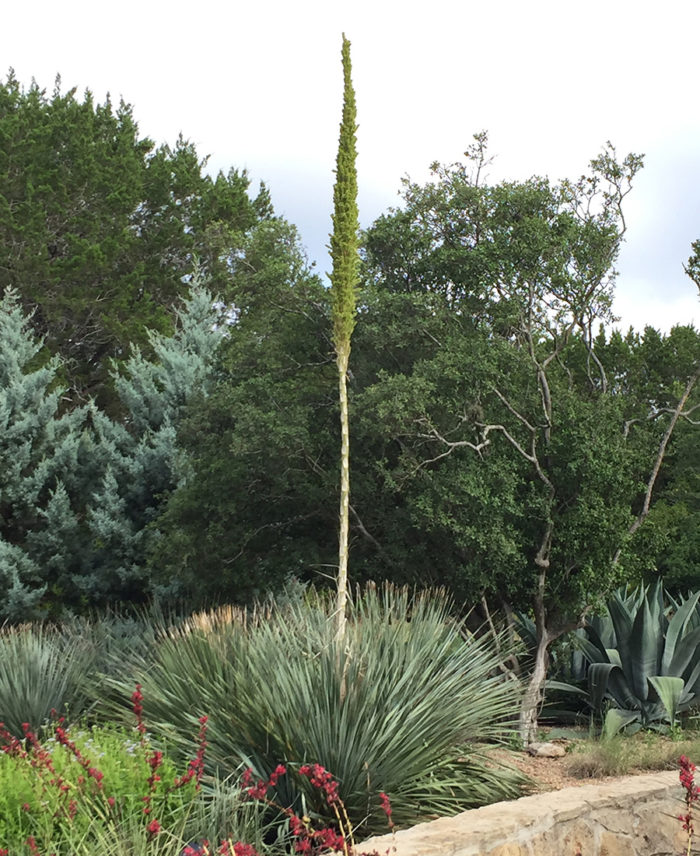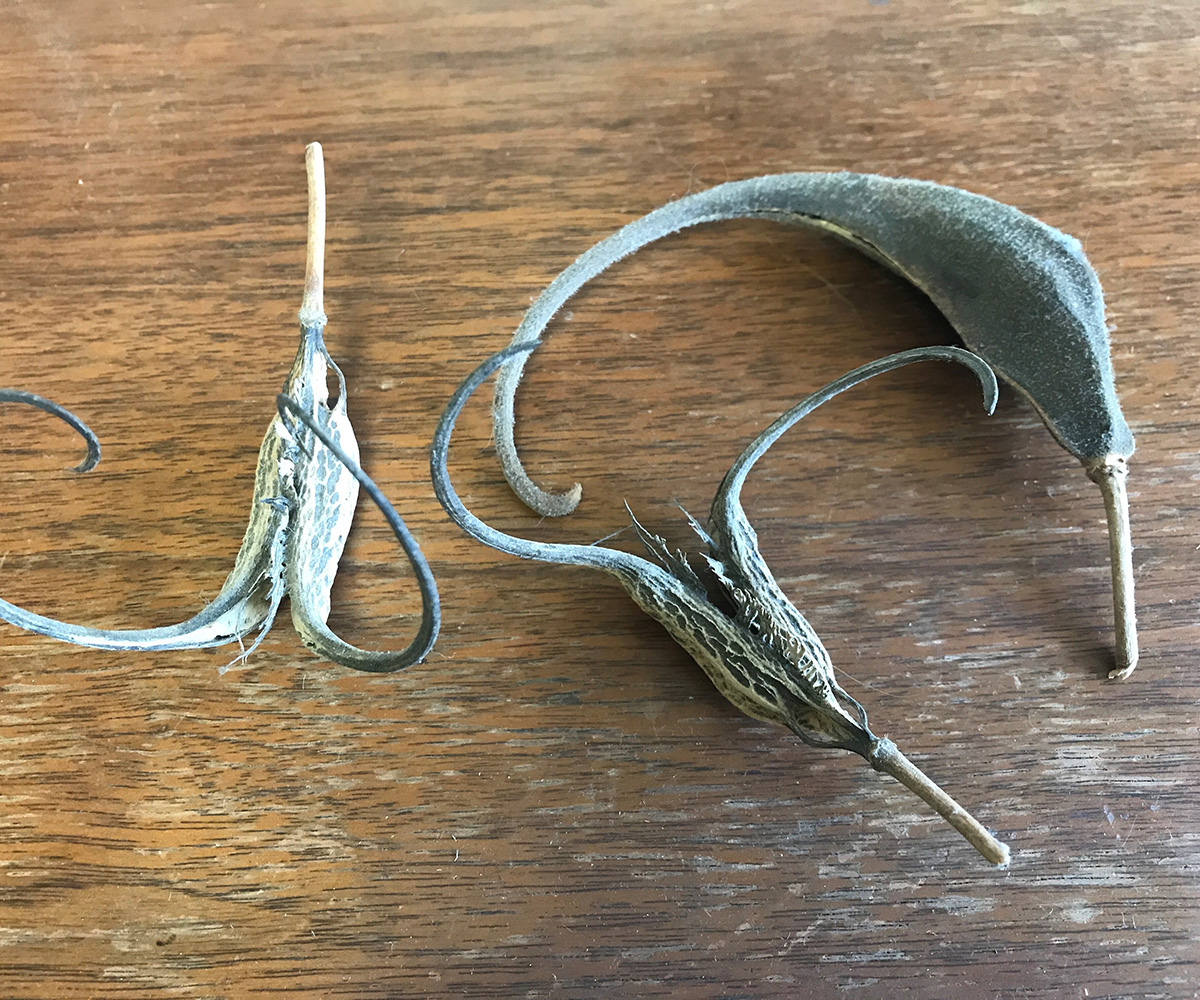
Some of my very favorite plants for our region are also the gnarliest, thorniest ones. While it might take a little extra planning when deciding where to plant them, they can be well worth your consideration.
Common sotol
Also known as: desert spoon, spoon yucca
Dasylirion wheeleri, Zones 8–11
This is a plant that requires you to wear sturdy pants. Common sotol is big, bold, and makes a dramatic statement in desert-themed or xeriscaped gardens. Frequently mistaken for a yucca (Yucca spp. and cvs., Zones 4–11), common sotol has long, narrow leaves with sharply serrated edges and a bluish green hue. The leaves originate from a single trunk, forming a large fountain that reaches up to about 5 to 6 feet in height and diameter. Every few years the plant produces a tall, pole-like flower stalk, which is an impressive sight (and makes an excellent walking stick). Sotol only thrives in the southern part of our region, as it is native to desert climates and won’t tolerate extended frosts.
 |
 |
| Like many palo verdes, Mexican palo verde produces an abundance of small, delicate yellow flowers. But watch out for thorns when leaning in for a sniff. Photos: Karen Beaty |
Mexican palo verde
Also known as: retama, Jerusalem thorn
Parkinsonia aculeata, Zones 8–11
Mexican palo verde is a thorny but delicately beautiful small tree. Palo verde means “green stick” in Spanish; the tree got its name because in periods of extreme drought it will lose its leaves, and the trunk and branches will turn green and take over photosynthesis. It can reach heights of about 36 feet tall, but 15 feet is more typical. Mexican palo verde has long, drooping branches that bear delicate, narrow leaves and yellow flowers. Younger stems have a pair of sharp thorns below each leaf, which persist even as the stem ages and the leaf falls off. Because of these thorns, Mexican palo verde is best located out where garden visitors can’t be snagged.
 |
 |
| Both the pads and fruits of Texas prickly pear are edible and widely used in cooking. These magenta fruits are produced from bright, deeply yellow flowers. Photos: Karen Beaty |
Texas prickly pear
Opuntia engelmannii var. lindheimeri. Zones 8–11
Texas prickly pear really is a tried-and-true thorny wonder for our region. What other plant is as regal, resilient, tough, and downright useful? A true cactus, prickly pear has oval pads that are green to bluish-green and covered with yellow spines and fine, irritating hairs called glochids. It can take on a regal upright form or sprawl, reaching heights of about 6 feet, often with a width to match. Prickly pear is extremely drought tolerant and will thrive in full sun to partial shade. Propagation is as simple as throwing a single pad on the ground and letting it root in place. The pads and the fruits (which are dark purple and known as tunas) are edible and feature in traditional Mexican cuisine. The yellow blooms, which occur along the edges of the pads, are bright and cheerful and always a welcome sight.
 |
 |
| Delicate white blooms morph into dark seedpods with split, rough edges that resemble claws or horns. Photos: Karen Beaty |
Devil’s claw
Also known as: ram’s horn
Proboscidea louisianica ssp. louisianica, annual
I would be remiss if I didn’t mention this unique, thorny beauty. Devil’s claw has a truly unusual collection of characteristics: it stinks, it has gorgeous blooms, it’s sticky, and it has thorny, alien-looking seedpods. The beautiful pinkish white blooms, which resemble foxglove flowers, are the perfect landing pads for the bumblebees that pollinate them. The foliage is somewhat oily, and the oil carries a distinct scent that some find unpleasant. I find that it isn’t noticeable unless the plant is disturbed. Devil’s claw is named for its unusual seedpods, which are edible while immature and have a flavor akin to okra. If the seedpods are left to mature on the plant, they become woody and the elongated pod splits into two long, thorny claws. These dried pods have an unusual beauty and are often collected and used for arts and crafts, including basket weaving. While devil’s claw can be a nuisance in pastures where livestock graze, it makes a beautiful and unusual addition to garden beds. Thought to be native to the southern and southwestern United States, it is now naturalized in much of the mainland United States, as well as in Australia, Europe, and South Africa.
—Karen Beaty is a horticulturalist at the Lady Bird Johnson Wildflower Center in Austin, Texas.
Fine Gardening Recommended Products

SHOWA Atlas 370B Nitrile Palm Coating Gloves, Black, Medium (Pack of 12 Pairs)
Fine Gardening receives a commission for items purchased through links on this site, including Amazon Associates and other affiliate advertising programs.

ARS Telescoping Long Reach Pruner
Fine Gardening receives a commission for items purchased through links on this site, including Amazon Associates and other affiliate advertising programs.

Pruning Simplified: A Step-by-Step Guide to 50 Popular Trees and Shrubs
Fine Gardening receives a commission for items purchased through links on this site, including Amazon Associates and other affiliate advertising programs.



















Comments
Log in or create an account to post a comment.
Sign up Log in